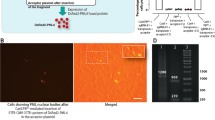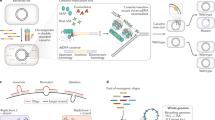Abstract
Several studies, some of which have been updated during the recent workshop entitled Genome Medicine: Gene Therapy for the Millennium (Rome, 30 September–3 October 2001), have highlighted the usefulness of extrachromosomal or episomal genes in gene targeting strategies. Due to the selectable nature of antibiotic resistance and reporter genes, targeted correction of mutated versions of these extrachromosomal genes allows an accurate quantification of correction frequency. In addition, these model systems facilitate and speed up the optimization of critical parameters for the successful application of gene targeting approaches. In fact, type of cell line, gene delivery system, molar ratio of episomal target/therapeutic constructs, nature and design of therapeutic complexes and different recombinative proteins may be critical for the actual feasibility of each method. Although virus-based approaches are now being investigated as well, this article is focusing on the targeted correction of extrachromosomal genes by the use of small DNA fragments (SDF), chimeric RNA/DNA oligonucleotides (RDO) and triplex-forming oligonucleotides (TFO).
This is a preview of subscription content, access via your institution
Access options
Subscribe to this journal
Receive 12 print issues and online access
$259.00 per year
only $21.58 per issue
Buy this article
- Purchase on Springer Link
- Instant access to full article PDF
Prices may be subject to local taxes which are calculated during checkout
Similar content being viewed by others
References
Yanez RJ, Porter AC . Therapeutic gene targeting Gene Therapy 1998 5: 149–159
Gruenert DC . Gene correction with small DNA fragments Curr Res Molec Ther 1998 1: 607–613
Kunzelmann K et al. Gene targeting of CFTR DNA in CF epithelial cells Gene Therapy 1996 3: 859–867
Goncz KK, Kunzelmann K, Xu Z, Gruenert DC . Targeted replacement of normal and mutant CFTR sequences in human airway epithelial cells using DNA fragments Hum Mol Genet 1998 7: 1913–1919
Gruenert DC . Opportunities and challenges in targeting genes for therapy Gene Therapy 1999 6: 1347–1348
Goncz KK, Gruenert DC . Site-directed alteration of genomic DNA by small-fragment homologous replacement Meth Mol Biol 2000 133: 85–99
Goncz KK et al. Expression of DeltaF508 CFTR in normal mouse lung after site-specific modification of CFTR sequences by SFHR Gene Therapy 2001 8: 961–965
Kapsa R et al. In vivo and in vitro correction of the mdx dystrophin gene nonsense mutation by short-fragment homologous replacement Hum Gene Ther 2001 12: 629–642
Alexeev V, Yoon K . Stable and inheritable changes in genotype and phenotype of albino melanocytes induced by an RNA-DNA oligonucleotide Nature Biotech 1998 16: 1343–1346
Kmiec EB . Targeted gene repair Gene Therapy 1999 6: 1–3
Bandyopadhyay P et al. Nucleotide exchange in genomic DNA of rat hepatocytes using RNA/DNA oligonucleotides. Targeted delivery of liposomes and polyethyleneimine to the asialoglycoprotein receptor J Biol Chem 1999 274: 10163–10172
Rando TA, Disatnik MH, Zhou LZ . Rescue of dystrophin expression in mdx mouse muscle by RNA/DNA oligonucleotides Proc Natl Acad Sci USA 2000 97: 5363–5368
Bartlett RJ et al. In vivo targeted repair of a point mutation in the canine dystrophin gene by a chimeric RNA/DNA oligonucleotide Nat Biotechnol 2000 18: 615–622
Tagalakis AD et al. Gene correction of the apolipoprotein (Apo) E2 phenotype to wild-type ApoE3 by in situ chimeraplasty J Biol Chem 2001 276: 13226–13230
Culver KW et al. Correction of chromosomal point mutations in human cells with bifunctional oligonucleotides Nat Biotechnol 1999 17: 989–993
Casey BP, Glazer PM . Gene targeting via triple-helix formation Prog Nucleic Acid Res Mol Biol 2001 67: 163–192
Knauert MP, Glazer PM . Triplex forming oligonucleotides: sequence-specific tools for gene targeting Hum Mol Genet 2001 10: 2243–2251
Vasquez KM, Dagle JM, Weeks DL, Glazer PM . Chromosome targeting at short polypurine sites by cationic triplex-forming oligonucleotides J Biol Chem 2001 276: 38536–38541
Vasquez KM, Dagle JM, Weeks DL, Glazer PM . Chromosome targeting at short polypurine sites by cationic triplex-forming oligonucleotides Colosimo A et al. Transfer and expression of foreign genes in mammalian cells. Biotechniques 2000; 29: 314–318, 320-322, 324 passim
Igoucheva O, Alexeev V, Yoon K . Targeted gene correction by small single-stranded oligonucleotides in mammalian cells Gene Therapy 2001 8: 391–399
Strauss M . The site-specific correction of genetic defects Nature Med 1998 4: 274–275
Santana E et al. Different frequency of gene targeting events by the RNA-DNA oligonucleotide among epithelial cells J Invest Dermatol 1998 111: 1172–1177
Russell DW, Hirata RK . Human gene targeting by viral vectors Nat Genet 1998 18: 325–330
Morrison C, Wagner E . Extrachromosomal recombination occurs efficiently in cells defective in various DNA repair systems Nucleic Acid Res 1996 24: 2053–2058
Colosimo A et al. Targeted correction of a defective selectable marker gene in human epithelial cells by small DNA fragments Mol Ther 2001 3: 178–185
Thorpe P, Stevenson B, Gohil A, Porteous D . Towards CFTR gene correction: a comparison of two key strategies Pediatric Pulmonol 2000 241
Holmes AR et al. Intracellular compartmentalization of DNA fragments in cultured airway epithelial cells mediated by cationic lipids Pharm Res 1999 16: 1020–1025
Sangiuolo F et al. In vitro correction of CF epithelial cells using SFHR techniques Eur J Hum Genet 2001 1640
Yoon K, Cole-Strauss A, Kmiec EB . Targeted gene correction of episomal DNA in mammalian cells mediated by a chimeric RNA.DNA oligonucleotide Proc Natl Acad Sci USA 1996 93: 2071–2076
Cole-Strauss A et al. Targeted gene repair directed by the chimeric RNA/DNA oligonucleotide in a mammalian cell-free extract Nucleic Acids Res 1999 27: 1323–1330
Beetham PR et al. A tool for functional plant genomics: chimeric RNA/DNA oligonucleotides cause in vivo gene-specific mutations Proc Natl Acad Sci USA 1999 96: 8774–8778
Igoucheva O, Peritz AE, Levy D, Yoon K . A sequence-specific gene correction by an RNA-DNA oligonucleotide in mammalian cells characterized by transfection and nuclear extract using a lacZ shuttle system Gene Therapy 1999 6: 1960–1971
Liu L, Rice MC, Kmiec EB . In vivo gene repair of point and frameshift mutations directed by chimeric RNA/DNA oligonucleotides and modified single-stranded oligonucleotides Nucleic Acids Res 2001 29: 4238–4250
Kren BT, Metz R, Kumar R, Steer CJ . Gene repair using chimeric RNA/DNA oligonucleotides Semin Liver Dis 1999 19: 93–104
Wang G, Levy DD, Seidman MM, Glazer PM . Targeted mutagenesis in mammalian cells mediated by intracellular triple helix formation Mol Cell Biol 1995 15: 1759–1768
Chan PP et al. Targeted correction of an episomal gene in mammalian cells by a short DNA fragment tethered to a triplex-forming oligonucleotide J Biol Chem 1999 274: 11541–11548
Kren BT, Bandyopadhyay P, Steer CJ . In vivo site-directed mutagenesis of the factor IX gene by chimeric RNA/DNA oligonucleotides Nat Med 1998 4: 285–290
Goncz K et al. Modification of a single base pair in the beta-globin locus in vitro by site-specific gene targeting Molec Ther 2001 3: 712
Acknowledgements
This work was supported by a grant of the Italian Ministry of Health.
Author information
Authors and Affiliations
Rights and permissions
About this article
Cite this article
Colosimo, A., Guida, V., Palka, G. et al. Extrachromosomal genes: a powerful tool in gene targeting approaches. Gene Ther 9, 679–682 (2002). https://doi.org/10.1038/sj.gt.3301749
Published:
Issue Date:
DOI: https://doi.org/10.1038/sj.gt.3301749



